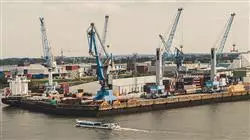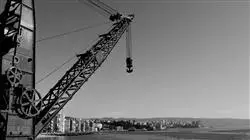University certificate
The world's largest faculty of engineering”
Introduction to the Program
A complete specialization that compiles the latest advances and ways of working in Port Layout , with the best teaching quality on the online market"

This Postgraduate diploma is configured on the basis of modules of high educational impact that will take you through the most advanced knowledge in Port Layout .
The Maritime Climate and Wave Study module begins with the study of wave and swell theory, including the characterization of waves and their breaking forms. It also includes the determination of the rest of the maritime climate parameters, the methodology for data collection, the maritime climate ROM program and, finally, the study of the physical wave models and the compilation of the most important software available in maritime engineering.
The Maritime Port Layout and Berthing Works module is the first port infrastructure design module of the Postgraduate diploma. Firstly, it focuses on the maritime layout of the Port including both plan and elevation dimensioning. Sizing is based on the ROM Maritime Works Recommendations.
Due to the globalization of the economy, logistics, which has become the competitive engine for trade and industry, is reducing the time and cost of transportation and evolving in ways that increasingly reduce negative environmental and social impacts.
During the execution of port infrastructure works, knowledge of the different specific work units, construction materials and the appropriate choice of machinery plays a fundamental role.
This is why it is essential to plan the construction properly and always taking into account the different recommendations issued by official bodies such as State Ports and the experience of experts in the field, the module also develops the content of the Guide of Good Practices in the Execution of Maritime Works issued by that institution.
A complete in-depth study of the most current criteria in the different aspects of Port Layout ”
This Postgraduate diploma in Port Layout contains the most complete and up-to-date educational program on the market. Its most notable features are:
- The development of practical cases presented by experts in Port Layout
- The graphic, schematic, and practical contents with which they are created provide scientific and practical information on the disciplines that are essential for professional development
- Practical exercises where self-assessment can be used to improve learning
- Its special emphasis on innovative methodologies in Port Layout
- Theoretical lessons, questions to the expert, debate forums on controversial topics, and individual reflection assignments
- Content that is accessible from any fixed or portable device with an Internet connection
A quality program that will allow you not only to follow the specialization, but also to have complementary support and information banks available"
Its teaching staff includes professionals from the field of civil engineering, who bring to this specialization the experience of their work, as well as recognized specialists from leading companies and prestigious universities.
The multimedia content, developed with the latest educational technology, will provide the professional with situated and contextual learning, i.e., a simulated environment that will provide immersive learning programmed to learn in real situations.
This program is designed around Problem-Based Learning, whereby the professional must try to solve the different professional practice situations that arise throughout the Postgraduate diploma. For this purpose, the professional will be assisted by an innovative interactive video system developed by renowned and experienced experts in Port Layout .
This program has the best teaching material available online or downloadable, to make it easier for you to manage your study and effort”

A very complete specialization, created with the objective focused on bringing our students to the highest level of competence”
Why study at TECH?
TECH is the world’s largest online university. With an impressive catalog of more than 14,000 university programs available in 11 languages, it is positioned as a leader in employability, with a 99% job placement rate. In addition, it relies on an enormous faculty of more than 6,000 professors of the highest international renown.

Study at the world's largest online university and guarantee your professional success. The future starts at TECH”
The world’s best online university according to FORBES
The prestigious Forbes magazine, specialized in business and finance, has highlighted TECH as “the world's best online university” This is what they have recently stated in an article in their digital edition in which they echo the success story of this institution, “thanks to the academic offer it provides, the selection of its teaching staff, and an innovative learning method aimed at educating the professionals of the future”
A revolutionary study method, a cutting-edge faculty and a practical focus: the key to TECH's success.
The most complete study plans on the university scene
TECH offers the most complete study plans on the university scene, with syllabuses that cover fundamental concepts and, at the same time, the main scientific advances in their specific scientific areas. In addition, these programs are continuously being updated to guarantee students the academic vanguard and the most in-demand professional skills. In this way, the university's qualifications provide its graduates with a significant advantage to propel their careers to success.
TECH offers the most comprehensive and intensive study plans on the current university scene.
A world-class teaching staff
TECH's teaching staff is made up of more than 6,000 professors with the highest international recognition. Professors, researchers and top executives of multinational companies, including Isaiah Covington, performance coach of the Boston Celtics; Magda Romanska, principal investigator at Harvard MetaLAB; Ignacio Wistumba, chairman of the department of translational molecular pathology at MD Anderson Cancer Center; and D.W. Pine, creative director of TIME magazine, among others.
Internationally renowned experts, specialized in different branches of Health, Technology, Communication and Business, form part of the TECH faculty.
A unique learning method
TECH is the first university to use Relearning in all its programs. It is the best online learning methodology, accredited with international teaching quality certifications, provided by prestigious educational agencies. In addition, this disruptive educational model is complemented with the “Case Method”, thereby setting up a unique online teaching strategy. Innovative teaching resources are also implemented, including detailed videos, infographics and interactive summaries.
TECH combines Relearning and the Case Method in all its university programs to guarantee excellent theoretical and practical learning, studying whenever and wherever you want.
The world's largest online university
TECH is the world’s largest online university. We are the largest educational institution, with the best and widest online educational catalog, one hundred percent online and covering the vast majority of areas of knowledge. We offer a large selection of our own degrees and accredited online undergraduate and postgraduate degrees. In total, more than 14,000 university degrees, in eleven different languages, make us the largest educational largest in the world.
TECH has the world's most extensive catalog of academic and official programs, available in more than 11 languages.
Google Premier Partner
The American technology giant has awarded TECH the Google Google Premier Partner badge. This award, which is only available to 3% of the world's companies, highlights the efficient, flexible and tailored experience that this university provides to students. The recognition as a Google Premier Partner not only accredits the maximum rigor, performance and investment in TECH's digital infrastructures, but also places this university as one of the world's leading technology companies.
Google has positioned TECH in the top 3% of the world's most important technology companies by awarding it its Google Premier Partner badge.
The official online university of the NBA
TECH is the official online university of the NBA. Thanks to our agreement with the biggest league in basketball, we offer our students exclusive university programs, as well as a wide variety of educational resources focused on the business of the league and other areas of the sports industry. Each program is made up of a uniquely designed syllabus and features exceptional guest hosts: professionals with a distinguished sports background who will offer their expertise on the most relevant topics.
TECH has been selected by the NBA, the world's top basketball league, as its official online university.
The top-rated university by its students
Students have positioned TECH as the world's top-rated university on the main review websites, with a highest rating of 4.9 out of 5, obtained from more than 1,000 reviews. These results consolidate TECH as the benchmark university institution at an international level, reflecting the excellence and positive impact of its educational model.” reflecting the excellence and positive impact of its educational model.”
TECH is the world’s top-rated university by its students.
Leaders in employability
TECH has managed to become the leading university in employability. 99% of its students obtain jobs in the academic field they have studied, within one year of completing any of the university's programs. A similar number achieve immediate career enhancement. All this thanks to a study methodology that bases its effectiveness on the acquisition of practical skills, which are absolutely necessary for professional development.
99% of TECH graduates find a job within a year of completing their studies.
Postgraduate Diploma in Port Layout
Elements such as specific work units, construction materials and the proper choice of machinery are essential in the field of port configuration. For this reason, the knowledge of engineering professionals for planning and good practices in the execution of works of a maritime nature is fundamental. They must not only know the general parameters and tools for working on docks, but also the specific recommendations issued by government agencies that warn about the specific conditions of the port where such works are being developed. This is due to the fact that only the professional's mastery of these issues will determine the success of his work. In TECH Global University we designed a Postgraduate Diploma in Port Configuration, aimed at updating the knowledge of professionals on the maritime configuration of a port.
Become an expert in the management and logistics of maritime works
If among your objectives is to be able to work with skill and ability in the field of port infrastructures, this program is for you. With this program you will have the opportunity to delve into the study of wave and surge theory, the structural design of berthing works and the most relevant concepts for the design and construction of maritime works, as well as the factors that influence them. At the end of this program, you will be able to deal with different situations in which decision making and problem solving actions are important for the project. In addition, you will have a global vision of the management, operation and maintenance of port infrastructures.
Titúlate in the university with the largest virtual Engineering Faculty
At TECH Global University we have the most complete and updated program in the educational market. This high-level intensive program will prepare you to face the various challenges that may arise in your field of specialty. You will study with our unique online teaching methodologies, completely remotely.







